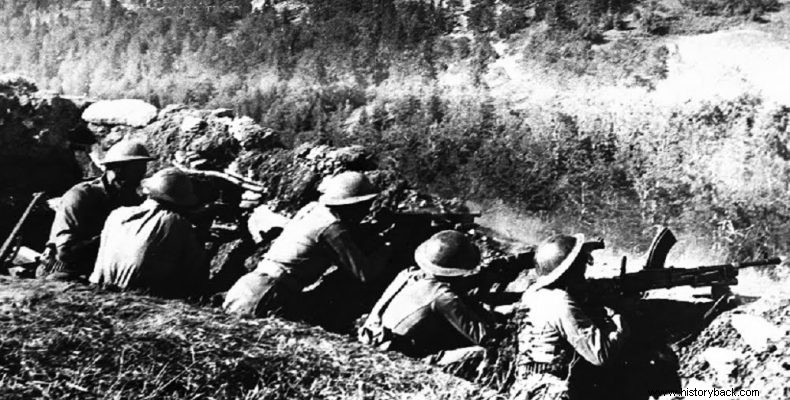
During the Civil War there were numerous border skirmishes between the Hellenic Army (HE) and Albanian, Bulgarian and Yugoslav forces. One of the most important incidents took place in the area of Koutsoubey Pella, in border Greece – Yugoslavia.
This particular episode developed into a real battle, with losses on both sides. Koutsoubey is one of the peaks of Mount Voras (Kaimaktsalan) at an altitude of 2399 meters, on the borders of the prefectures of Pella and Florina.
Often, during the Civil War, forces of the "Democratic Army of Greece" (DSE) passed through the area, through Yugoslav territory, to and from Vitsi. The ES, attempting to block the border, had set up outposts along the HIV-positive line with Yugoslavia.
After the Tito-Stalin split the flow of DSE fighters and materials had been limited, but a general irritation still existed in the region.
In August 1948, the 3rd SS was ordered to attack the rebel forces stationed in Kaimaktsalan, in order to prevent their movement towards Grammos, which at that time was being attacked by the SS.
On September 8, admittedly, the , strange, Yugoslav intervention in favor of the DSE.
During this period, forces of the 514th and 556th Infantry Battalions (TP) were deployed in the area of the Kutsumbey peak.
Unprovoked attack
In pyramid number 119 were two battle groups of the 3rd Company of the 556TP, led by an officer. The 1st Company of the 556TP was deployed to the right of Koutsoubey, at the height of 2157, while a battalion of the 514TP was deployed on the heights of Prophet Ilias (altitude 2524) and Stalo (altitude 2236).
At 14.30 in the afternoon of September 8 the battle groups, deployed on the positive line, became aware of the movement of strong forces from Yugoslav territory. The Yugoslav forces split into three phalanxes and gradually developed into battle formation and continued to move towards Greek territory. The Greek forces – about 20 men – believed that these were units of the DSE that had taken refuge in Yugoslavia and were now coming back, as they did all the time.
Second Lieutenant Ioannis Kapetis immediately put the men on alert and began to take defensive measures. The 60mm light mortar. of the platoon took up position on the top of Kutsumbey and the other men deployed defensively on the rocks around trigonometric 119.
The Yugoslav forces continued their advance and a group, about 60 strong, invaded Greek territory. Immediately the Greek forces opened fire. But the Yugoslavs not only did not stop, but returned fire and two more groups invaded Greek territory, trying to encircle the Greek section.
Captain Kapetis, in order not to be surrounded, ordered a retreat to the top of Koutsoubey. There the Greek platoon deployed defensively. During the retreat, a Greek soldier, Vasilios Moisiadis, lost his orientation, also due to the thick fog covering the area, and was eventually captured by the invaders. Three other soldiers were lost, but eventually managed to rejoin the platoon shortly afterwards.
Second Lieutenant Kapetis managed to inform the 3rd Company of the events. At 3:15 p.m. the other two Yugoslav phalanxes moved on the south-western slope of Kuchoubey and penetrated to a depth of 1,500 m into Greek territory and simultaneously assaulted Kuchoubey and the Command Station of the 3rd Company!
The battle continued, with the Yugoslavs rushing against the Greek positions and the Greeks defending heroically. The two opponents were separated by just a few meters and the battle turned into a duel with grenades, at a distance of less than 20m. Until 17.15 the battle lasted with the lone company defending itself against the fierce Yugoslav attacks.
Greek victory
But then the 1st Company of the 556TP, which had been alerted in the meantime, arrived on the battlefield. This Company occupied with two platoons the rocky buttresses on both sides of the neck between Kuchumbey and H. 2260, south-east of Kuchumbey, thereby stopping the Yugoslav attempt to encircle the 3rd Company and with its 3rd platoon, reinforced the defenders of the 3rd Company.
At that moment, around 17.30, the fog cleared, so the Greek artillery and the mortars of the 556TP entered the fight. Taking advantage of the support fire, the two Greek companies launched a swift counterattack.
The cry of "Air" was heard again on the mountain tops and the Yugoslavs fled. However, the funny thing about the case was that until then the Greek forces continued to believe that they were fighting against rebels . But when they approached the positions occupied by the Yugoslavs and saw the dead, they realized that for so many hours they had been fighting with units of the regular Yugoslav Army.
Soon the fact was confirmed by the capture of a Yugoslav prisoner – the next day two more soldiers were captured.
The Yugoslavs had fled, leaving behind 17 dead (two officers) and three prisoners. They also abandoned four submachine guns, seven submachine guns, four rifles, grenades, machine gun cartridges and anti-tank rifle cartridges , all of Soviet origin. Greek losses were insignificant – five wounded and one missing.
During the battle, three Yugoslav soldiers, Abdullah Busanic (Bosnian), Milorad Nesovanic (Serb) and Franjo Toplek (Croat) were captured. The prisoners, after questioning, testified that they belonged to the 1st Battalion (the first two of the 1st Company and the third of the 2nd Company) of the 42nd Brigade of the II Division based in Monastiri.
Their Battalion consisted of four rifle companies of about 100 men each and a company of heavy weapons – mortars and machine guns. In total, the strength of the battalion reached 480 men.
